Humans are champs at avoiding work. From the moment we wake up, we use machines to brush our teeth, brew our coffee and open our garage doors. We embrace anything that helps unburden us from unnecessary thought or movement. It’s no wonder so many people automatically gravitate to the machines at the gym.
“With machines, you’re in a supported environment where the most difficult challenge is the load. With free weights, on the other hand, you not only have to control the load, you also have to control the integrity of your body. In a nutshell, that’s real life,” says Charlie Weingroff, PT, ATC, CSCS, physical therapist for the U.S. Marine Corps.
Thanks to all that real-life challenge, free weights can also help you burn more calories, become a better athlete and build more muscle mass.
That doesn’t mean machines are useless, though. Most experts find both types of equipment to be valuable tools in a resistance-training program. But if you’ve yet to get a grip on dumbbells and barbells, it’s time to revamp your routine. Here’s what you need to know, and how to put it to good use.
Move Better
No matter what your fitness goals are, experts agree on one thing: Exercise should prepare you for life. “It’s about being able to control the forces in your environment,” says Craig Friedman, MS, ATC, CSCS, vice president of performance innovation for Core Performance in Norwell, Mass.
Using free weights can help accomplish this. “What free-weight exercises tend to have in common is they have a broad skill carryover. Whether you’re picking up a child, moving a piece of furniture, tossing an object or sprinting, these are all ‘free weight’ activities,” says Steven Plisk, MS, sports performance consultant and director of Excelsior Sports in Derby, Conn.
Consider a dead lift, for example. This exercise requires you to engage your hips, abdominals and spinal stabilizers to control your body against gravity, much like you would in everyday life. On the other hand, a leg press that’s done on a machine “doesn’t transfer to picking up a large bag of dog food,” says Weingroff. The problem with a leg press is that you’re leaving out your entire axial skeleton — the spine, pelvis and trunk, he explains.
Free weights also require greater demand from your nervous system than a machine does. As in the real world, your mind must tell your muscles when to fire and how to work together to produce movement, says Friedman.
For certain populations, such as people with motor-control disorders, machines can play a valuable role in maintaining functional strength, says Jason Stella, NASM-PES, CES, Life Time Academy program manager for Life Time Fitness in Chanhassen, Minn. “If someone has a muscle that’s atrophying and you use a machine to slow that down, it’s functional,” says Stella.
Given the choice, however, many trainers steer their clients toward free weights more often than machines. “With free weights, you get more bang for your buck,” says Friedman. “You’re not just training for strength but to be reactive. You’re making your nervous system smarter.”
Lose Fat
If you’re looking to shrink your waistline, it pays to incorporate full-body movements into your workout. “Your body is generally more active with free weights, so you have a higher energy expenditure. You can perform bigger, compound movements,” says Friedman. “For example, with a machine, you can either do an overhead press or a squat-type movement. With free weights, you can do a squat-to-press, which will make you work harder.”
Doing multijoint exercises and manipulating variables such as sets, reps and rest intervals elicits more of a hormonal response, says Stella. The bigger the muscle, the more lactic acid produced, resulting in more growth hormone and testosterone, which help build muscle and burn fat.
“That’s why resistance training has a positive effect on fat loss,” Stella says. It’s not just the type of exercise that promotes fat loss, but the cardiovascular demand of your entire workout. In this respect, both free weights and machines can be effective tools, but free weights may reduce transition time between exercises. “You’re able to keep your heart rate up because you’re not waiting in line for a machine,” says Friedman.
Master Your Sport
Free-weight exercises also better transfer to athletics. “When you play a sport, you’re focused on developing more power and raw force,” Plisk says. “It’s tough to develop these on a machine, especially if you’re doing isolation exercises.”
Free-weight movements such as a power clean or snatch allow you to generate force similar to what you would need for your sport. Numerous studies have found exercises such as squats, dead lifts and lunges result in improved speed, jumping ability and power.
“If you’re an athlete in virtually any sport, you will benefit from doing squats and dead lifts with good form,” says Lou Schuler, CSCS, coauthor of The New Rules of Lifting: Six Basic Moves for Abs. “You’re never going to find a machine that has that much of a carryover to performance.”
Complex movements, such as overhead squatting, and unilateral movements, such as pulling with one arm at a time, are often difficult to replicate with machines. But one can easily perform these actions with free weights. You build more functional strength because free weights force your muscles to work together, much as they would while sprinting or playing basketball, to solve the problem of gravity.
Pack on Muscle
Several factors contribute to muscle growth, including number of repetitions, tempo and rest time. Equipment is not a major variable, says Stella. Still, if you understand how machines and free weights work, you can use both to your advantage.
Machines may in fact allow you to isolate a muscle more effectively than free weights. “You can generate more force and place more load directly on the muscles without challenging your balance,” says Schuler. Machines also provide consistent resistance through the entire range of motion of an exercise, says Nick Tumminello, ACE-CPT, a performance coach in Baltimore.
For some exercises, however, free weights permit a greater range of motion, says Stella. And they also allow for more variety, which is crucial in recruiting different muscle fibers. You can change your grip to over-under, or narrow or widen your hand position to change the plane of the exercises.
Even if your goal is to look like an action hero, you still need to develop functional strength. “You don’t want to be all show and no go,” says Tumminello. He suggests starting your workout with free-weight exercises and finishing with isolation exercises on machines. This way, you will be fresh when performing movements that require stability and coordination.
Make the Switch
The idea that beginners should stick with machines is a myth. “A lot of people seem to think they need to start out on a machine,” says Stella. “No machine is going to help you get better at free weights. You’re not going to get better at squats unless you squat.”
Ready to start exploring the world of free weights?
Here are our experts’ best bits of advice:
1. Practice patterns. All free-weight exercises involve a basic movement pattern. First, practice the movement of an exercise with little to no weight until you feel comfortable with your body position and alignment. “The main thing is to make sure your movement patterns are clean. Once you have the pattern down, you can challenge it with more resistance,” says Friedman.
2. Support yourself. If you’re not able to perform an exercise with proper form, you’ll want to add bases of support, says Stella. For example, a squat should take you slightly below parallel with your spine in its natural arch. If you can’t reach this position, start with your back against the wall. “Regress the movement pattern and learn it a little at a time,” Stella says.
3. Enlist professional help. “It’s really helpful to have a personal trainer who understands your limitations, medical conditions and risks,” says Cynthia Bauer, PT, DPT, OCS, director of musculoskeletal outpatient services for Good Shepherd Rehabilitation Network in Allentown, Pa. “You don’t want to be doing exercises that aggravate certain conditions or injuries.”
4. Expand your repertoire. Bauer suggests taking a strength class and using lighter weights as you become familiar with free weights. She also recommends using a chart with exercises that work similar muscles, so you’re not always doing the same movements. “It will educate you and keep you from getting bored,” she says.
5. Stand up for your body. “Chances are, you spend most of your life sitting on your butt, at your desk or computer, at home, and in your car. Why would you go to the gym and sit some more on a machine?” asks Tumminello. “Most free weights get you standing on your feet and force you to use muscles that don’t get worked from a seated position.”
How to Move From Weight Machines to Free Weights
The most important exercises to perform with free weights are those that are multijoint and involve major muscle groups, says Charlie Weingroff, PT, ATC, CSCS, a physical therapist for the U.S. Marine Corps. These exercises incorporate your axial skeleton — your pelvis, spine and trunk — making them most relevant to everyday life.
Our experts selected the following five must-do moves. These exercises work the major muscle groups of the upper and lower body in a balanced fashion. Each also replaces a popular machine at the gym.
All require either a barbell (or weighted bar) or dumbbells. Both forms of resistance provide unique benefits. “Barbells demand less stabilization than dumbbells,” Weingroff says. “If you’re looking to increase lean body mass, a barbell is the best choice because it allows you to lift more weight, but if you’re looking to develop more shoulder stability, dumbbells may be better.” Dumbbells also prevent compensation when one side of the body is weaker, allowing you to correct muscle imbalances.
Note: These exercises can also be performed on one side of the body at a time. Along with preventing right-left strength imbalances, unilateral exercises also elicit a greater response from your core. To avoid rotation, your abdominal muscles and spinal stabilizers have to get involved. “Anytime you use one arm or one leg, you’re activating a different muscular pattern throughout your stabilization system,” Weingroff says. For upper-body exercises, simply hold a dumbbell in one hand. For squats and dead lifts, stand on one leg. Start without weights and gradually add resistance after you’ve mastered the movement pattern.
Squat
Substitute for: Machine leg press
Major muscles worked: Glutes, hamstrings, quadriceps
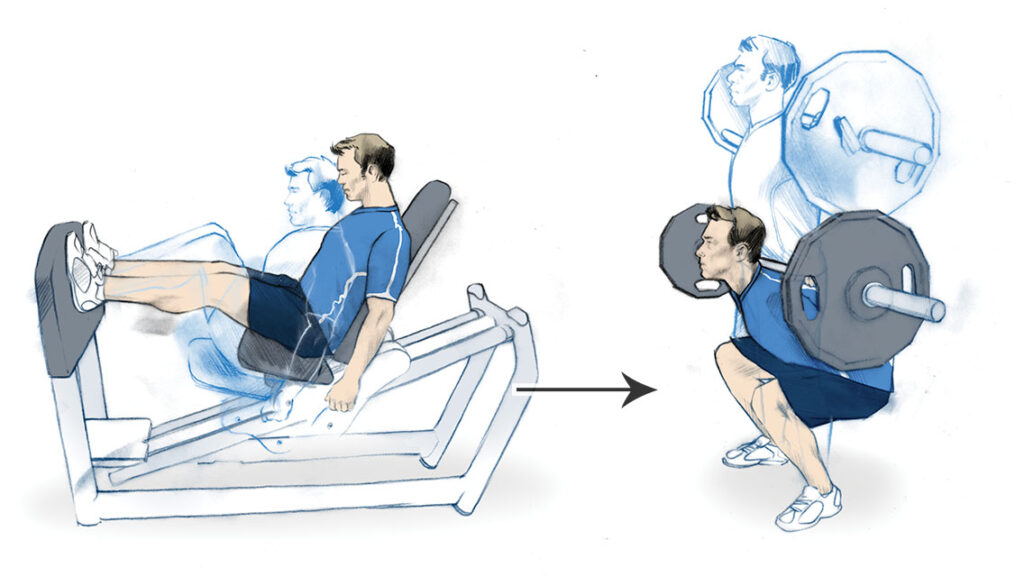
Free-weight advantage: Along with your quads and glutes, you’re also incorporating your hips, abdominal muscles and lower back to stabilize the movement. “It’s a much more natural movement than the leg press,” says Lou Schuler, coauthor of The New Rules of Lifting: Six Basic Moves for Abs. “You’re using the muscles the way they’re supposed to be worked.”
Barbell version:
- Start with a barbell placed evenly across your upper back, feet shoulder-width apart.
- Push your hips backward, letting your knees bend. Your back should maintain its natural arch. Your knees should track over your feet, and heels should stay on the floor.
- Go as low as you can while still maintaining good form.
- Return to standing.
Dumbbell version (not shown): Hold two dumbbells on your shoulders with wrists in line with shoulders and elbows pointing away from your body. Or, try a goblet squat: Hold one dumbbell vertically against your chest with both hands. This variation is easier to learn because the weight counterbalances your body, helping you maintain better posture, says Nick Tumminello, ACE-CPT, a performance coach in Baltimore. Also, a goblet squat does not require the shoulder and thoracic-spine mobility demanded by a barbell squat.
Bent-Over Row
Substitute for: Machine seated row
Major muscles worked: Lats, upper back (rhomboids, trapezius), posterior deltoids, biceps, spinal erectors
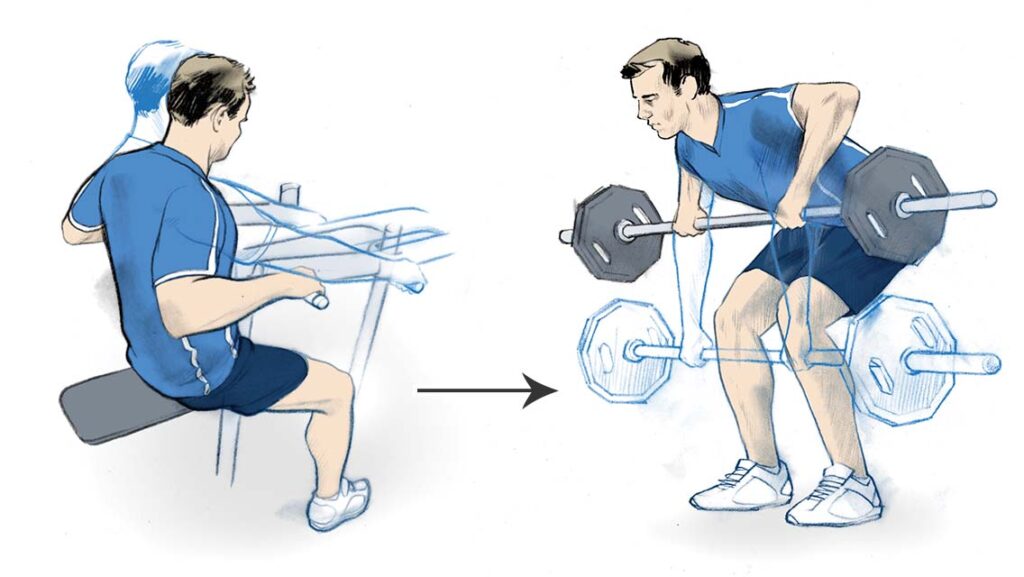
Free-weight advantage: “By standing in a bent-over position, you immediately activate your lumbar spinal muscles, glutes and hamstrings,” Tumminello says. You’re getting a two-for-one: building upper back and arm strength and lower-body stability.”
Barbell version:
- Stand upright with your feet hip-width apart, holding a barbell against the front of your thighs with a slightly-wider-than-shoulder-width overhand grip.
- Fold forward at the hips about 45 degrees, keeping your back flat and knees slightly bent. Keeping your body tight, pull the bar toward your upper abdomen. Pull your shoulder blades down and together in the middle of your back.
- Slowly return the bar to the start position.
Dumbbell version (not shown): Hold two dumbbells at your sides with a pronated (overhand), neutral (palms face inward) or supinated (underhand) grip to recruit different biceps muscles. The dumbbell version may allow for greater range of motion.
Bench Press
Substitute for: Machine chest press
Major muscles worked: Pectorals, deltoids, triceps
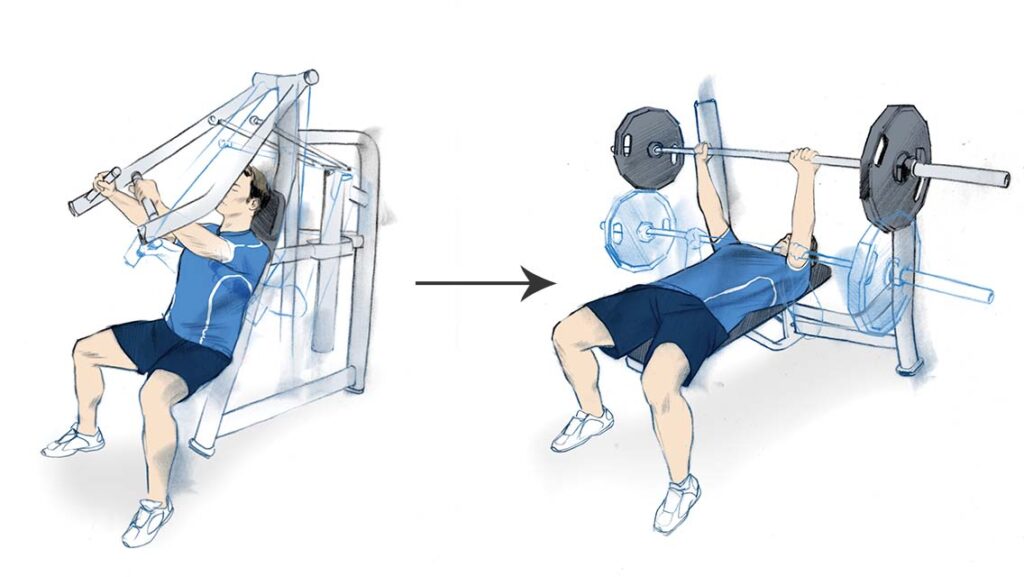
Free-weight advantage: You must use both limbs equally to stabilize the barbell or dumbbells, whereas a machine allows for the stronger arm to compensate, says Weingroff.
Barbell version:
- If you’re using a challenging weight, recruit a spotter. Lie flat on your back on a weight bench, maintaining the natural arch in your spine.
- With hands slightly wider than your shoulder width, grip the barbell overhand and unrack it until you’re holding it with straight arms above your chest.
- Bending your elbows, slowly lower the bar until it lightly touches your sternum. Keep your elbows at a 45-degree angle.
- Pushing your back into the bench and your feet into the floor, fully extend arms to push the bar back to the starting position.
Dumbbell version (not shown): Start by holding two dumbbells with arms straight above your chest, palms facing out (toward your feet). Lower the weights until they’re just above your chest; extend arms to return to start.
Dead Lift
Substitute for: Machine back extension
Major muscles worked: Glutes, hamstrings, spinal erectors, trapezius

Free-weight advantage: While the back extension machine attempts to work your lower back in isolation, the dead lift offers a natural movement in which your back muscles work in combination with the bigger, stronger muscles in your lower body. Thus, it translates better to everyday movements. “You’re picking up a weight off the floor; that’s probably the most functional exercise you can do,” Schuler says. “This teaches you to use your hips and not as much of your back, which is more vulnerable.”
Barbell version:
- Stand with feet hip-width apart, the barbell on the floor directly above the balls of your feet. Push your hips backward, bend your knees and grip the bar overhand or mixed grip.
- Slowly straightening your knees and pushing your hips forward, bring the bar back toward you and slowly rise to standing position with your shoulders back. Your back should maintain its natural arch throughout the range of motion. Slowly lower the bar to the floor.
Dumbbell version (not shown): Hold two dumbbells instead of a barbell.
Standing Overhead Press
Substitute for: Machine shoulder press
Major muscles worked: Deltoids, triceps, shoulders
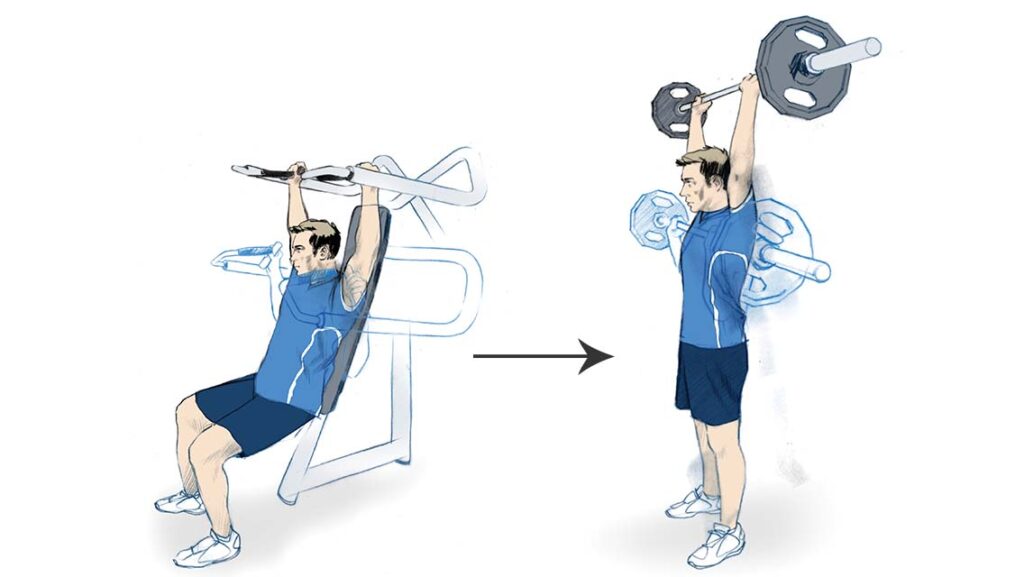
Free-weight advantage: “Having to control the spine and pelvis at the same time simulates a more real-life situation. Also, it makes this a full-body exercise,” says Weingroff. Once your movement pattern is good, using dumbbells results in maximal activation of shoulder stabilizer muscles.
Barbell version:
- With hands slightly wider than shoulder-width apart, unrack the weight with your elbows high and bent in front of the barbell, the weight resting on the fronts of your shoulders. Before beginning the lift, lock your shoulder blades down and together.
- Keeping your core tight, extend arms upward to lift the bar straight overhead. “Don’t overarch your spine as you lift the bar,” Weingroff says.
Dumbbell version (not shown): Hold two dumbbells just above your shoulders, elbows pointing in front of you at a 45-degree angle to your body. As you press the weights overhead, keep your hands neutral (palms facing inward). “This limits shoulder-impinging forces,” Tumminello says.
“Free Weights” Defined
Fitness experts hold varying philosophies on what qualifies as “free weights.” Some limit the category to dumbbells, barbells, kettlebells and other unattached objects that can be moved freely in space. Others include resistance bands, cables, body weight, and any form of resistance that allows the exerciser to control his or her movement pattern. The exercises described here correspond to the first definition.
As for machines, our experts are referring to the standard “selectorized” machine, on which you choose resistance by sliding a pin into a stack of weight plates, then perform a fully guided movement.
This article originally appeared as “Free Up Your Workout” in the October 2011 issue of Experience Life.


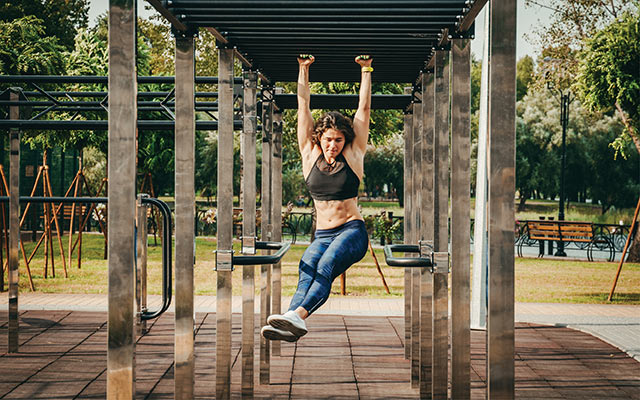
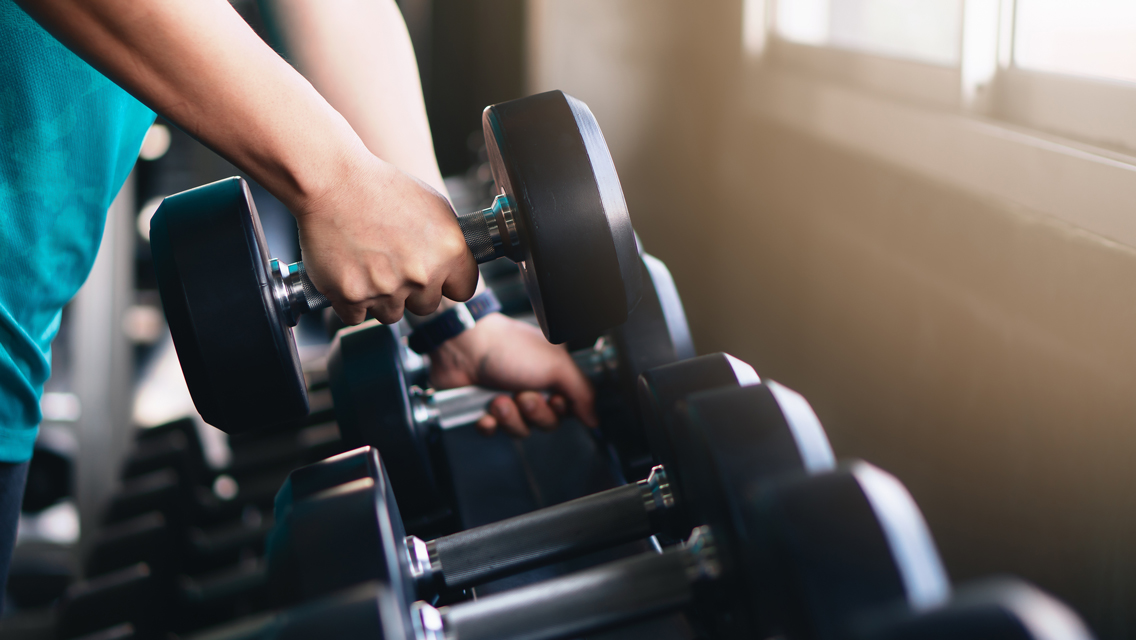

This Post Has 0 Comments